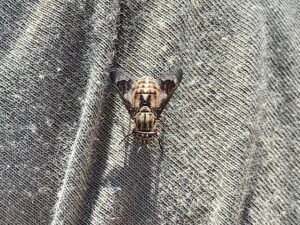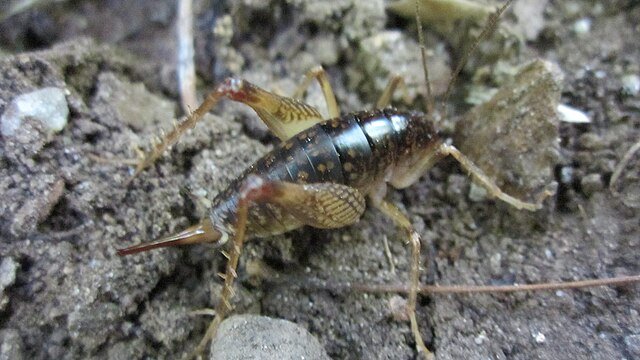Deer Flies (Chrysops spp.): How to Identify, Avoid, and Control These Painful Biters
 If you’ve ever been bitten by a small, fast, and incredibly persistent fly while hiking or working outdoors, you’ve probably met a deer fly (Chrysops spp.). These insects are notorious for their painful bites and relentless pursuit of humans and animals during warm summer months.
If you’ve ever been bitten by a small, fast, and incredibly persistent fly while hiking or working outdoors, you’ve probably met a deer fly (Chrysops spp.). These insects are notorious for their painful bites and relentless pursuit of humans and animals during warm summer months.
As a pest control expert and agronomist, I’ve heard the same complaint countless times: “They come out of nowhere, bite hard, and won’t stop chasing us!” Deer flies are one of the few pests that make even professionals frustrated because of how sneaky and mobile they are.
In this article, I’ll explain everything you need to know—how to recognize deer flies, what attracts them, and how to reduce their presence around your property.
Identification of Deer Flies
Deer flies are closely related to horse flies (Tabanus spp.), but they are generally smaller and more colorful.
Key identification features:
Size: 6–10 mm long (smaller than horse flies).
Color: Brown, gray, or yellowish body.
Eyes: Large, often with striking iridescent stripes or metallic colors.
Wings: Usually patterned with dark bands or spots.
Mouthparts: Cutting and sponging type—used to slice the skin and lap up blood.
They are often confused with stable flies (Stomoxys calcitrans) or black flies (Simulium spp.), but their distinctive colored eyes and patterned wings are a giveaway.
Adult deer flies are strong fliers, capable of chasing hosts for long distances, especially around wooded areas, rivers, and lakes.
Biology and Ecology
Understanding their life cycle is the first step to controlling them.
Scientific family: Tabanidae (same as horse flies).
Feeding habits:
Females feed on blood to develop eggs.
Males feed on nectar and pollen only.
Hosts: Humans, deer, cattle, horses, and other large mammals.
Breeding sites: Moist soil near ponds, wetlands, or forest edges.
Eggs: Females lay 100–800 eggs on vegetation overhanging water.
Larvae: Develop in damp soil or mud, feeding on decaying organic matter or small invertebrates.
Lifecycle length: Around 1 year from egg to adult, but adults live only a few weeks in summer.
They thrive in warm, humid environments and are most active during sunny, windless days—perfect conditions for outdoor recreation or farm work.
Global Distribution
Deer flies are found in almost all regions except Antarctica.
North America: Very common in forests and near lakes. Chrysops callidus and Chrysops vittatus are frequent species.
Europe: Found from Scandinavia to the Mediterranean; most active in late spring and summer.
Australia: Several local species are found near creeks and forested farmland.
Asia: Common across tropical and temperate regions, especially in rice-growing areas.
Africa and South America: Present in humid zones with dense vegetation and water bodies.
Wherever you have heat, moisture, and wildlife—you’ll probably have deer flies.
Risks and Damage
1. Painful Bites
Deer fly bites are extremely painful. Unlike mosquitoes, they cut the skin with their mouthparts. The bite can cause:
Bleeding and swelling
Red, itchy welts
Allergic reactions in sensitive individuals
They target the head, neck, and upper body, often flying in circles before attacking.
2. Disease Transmission
Deer flies are known mechanical vectors for some pathogens:
Tularemia (Francisella tularensis) – a bacterial infection affecting humans and animals.
Loa loa filariasis – a parasitic disease in tropical Africa.
Other animal diseases such as anaplasmosis in cattle.
Although disease transmission to humans is rare in most regions, the risk still exists where these diseases are endemic.
3. Economic Impact
In agriculture, deer flies can reduce productivity by stressing livestock. Cows and horses spend energy trying to avoid bites, leading to:
Lower milk yields
Reduced weight gain
Open sores that attract infections
For tourism and recreation, their presence can discourage outdoor activities near water and forests.
Signs of Infestation or High Activity
You usually notice deer flies because they make their presence very clear. Common signs include:
Persistent buzzing and biting around the head and shoulders outdoors.
Swarming near water, especially in mid-morning and afternoon.
Animals acting restless or running away from shaded areas.
Visible patterned flies resting on sunny surfaces near water.
Unlike house flies (Musca domestica), deer flies rarely enter homes—they prefer outdoor sunlight and movement.
Control Methods
Deer flies are among the hardest flying pests to control because they breed in natural environments you often can’t reach. Still, there are several effective strategies to reduce their numbers and protect yourself.
1. Personal Protection
Wear light-colored clothing: Dark colors attract them.
Use repellents: Products containing DEET, picaridin, or permethrin can reduce bites.
Avoid shiny jewelry and fragrances that attract insects.
Cover your head and neck with hats and scarves when working outdoors.
2. Environmental Management
Eliminate standing water where possible (ditches, puddles).
Trim tall grass and vegetation near water.
Remove decaying organic matter that supports larvae.
3. Trapping Systems
Deer fly traps rely on movement and dark color. Common designs include:
Blue or black sticky traps: Placed about 1–1.5 meters above ground level.
Ball traps: A dark ball coated with sticky substance mimics an animal target.
CO₂-baited traps: Attract flies using carbon dioxide, replicating animal breath.
4. Chemical Control
Insecticides provide limited success because deer flies breed over large natural areas. However:
Residual sprays can help around barns or outdoor seating areas.
Fogging or misting systems may give temporary relief in small zones.
Only apply pesticides following label instructions and local regulations.
5. Biological Control
Predators such as dragonflies, spiders, and birds naturally reduce deer fly populations. Promoting biodiversity near farms or wetlands helps maintain balance.
Advanced Approaches
For large properties or livestock operations, an Integrated Pest Management (IPM) plan works best. This includes:
Monitoring traps to measure activity levels.
Timing animal grazing to avoid peak fly hours (midday).
Using fans or air curtains in barns and stables—deer flies avoid strong airflow.
Installing fine mesh screens in open areas to protect workers.
Some studies also show promising results with repellent-treated clothing and essential oils like eucalyptus, citronella, or clove oil, though they must be reapplied often.
Cultural and Historical Context
Humans have battled deer flies for centuries. Ancient farmers in Europe and Asia described them as “summer demons” that tormented livestock. The name Chrysops literally means “golden eye,” referring to their colorful eyes that flash in sunlight.
In folklore, they were often linked to bad weather or forest spirits, because they appear just before thunderstorms. In modern times, they remain a symbol of summer irritation—proof that even a small insect can ruin a perfect picnic day.
Frequently Asked Questions (FAQ)
1. Do deer flies bite humans?
Yes, female deer flies bite humans and animals to get blood needed for egg development.
2. How painful are deer fly bites?
Very painful. The fly cuts the skin and feeds on the blood, leaving a red, swollen wound.
3. Can deer flies spread diseases?
Yes, they can transmit tularemia and some parasitic infections, but cases are uncommon in most regions.
4. How can I protect myself from deer flies outdoors?
Wear light-colored clothing, use repellents, and avoid outdoor activities near water during peak biting hours.
5. Do deer flies go indoors?
Rarely. They prefer open, sunny outdoor spaces.
6. Are deer flies attracted to specific colors?
Yes, they are drawn to dark colors and movement, especially blue and black.
7. What’s the difference between deer flies and horse flies?
Deer flies are smaller, have patterned wings, and are more common in wooded areas. Horse flies are larger, plain-winged, and often found near livestock.
8. Can I completely eliminate deer flies?
No, full elimination is nearly impossible, but consistent prevention and trapping can drastically reduce their numbers.
Final Thoughts
Deer flies (Chrysops spp.) are among the most aggressive biting flies found in nature. Unlike mosquitoes or gnats, their bite is sharp, painful, and often unexpected. While you can’t fully eliminate them due to their outdoor breeding habits, you can significantly reduce the risk of bites by combining repellents, traps, and environmental management.
As a pest control professional, I’ve seen that long-term success comes from consistency. You can’t just spray once and expect results. Keep vegetation low, reduce water sources, and use traps during the peak summer months. For livestock areas, add fans and physical barriers—deer flies hate strong airflow.
If you live near water or forested land, expect to see them every year. The goal isn’t total eradication but smart management that protects people and animals while respecting the environment.
Disclaimer
This article is for informational purposes only. Pest control laws and approved chemicals vary by country. For best results and legal safety, we strongly recommend contacting a licensed pest control professional in your local area. Always make sure that the pest control technician is properly certified or licensed, depending on your country’s regulations. It’s important to confirm that they only use approved products and apply them exactly as instructed on the product label. In most places in Europe, UK, or USA, following label directions is not just best practice—it’s the law.
Author
Nasos Iliopoulos
BSc Agronomist & Certified Pest Control Expert
Scientific Director – Advance Services (Athens, Greece)
Licensed Pest Control Business – Ministry of Rural Development & Food (GR)
References
University of Maryland - Horse and Deer Flies

